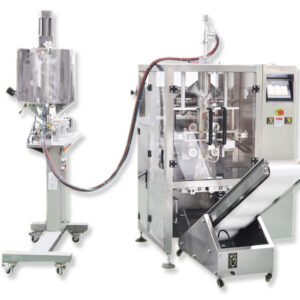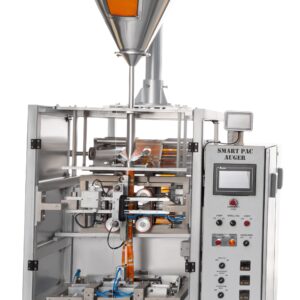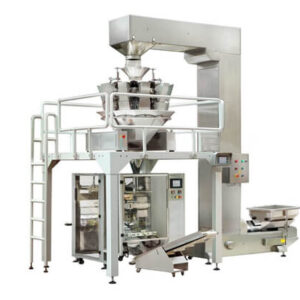Description
| Parameter | Specification |
|---|---|
| Capacity | 10-50 bags per minute |
| Filling Weight Range | 5-50 kg |
| Bag Type | Open mouth bags, valve bags, etc. |
| Accuracy | ±0.2% |
| Power Supply | 220V/380V, 50Hz |
| Power | 3-5 kW |
| Air Pressure | 0.6-0.8 MPa |
| Air Consumption | 0.8-1.0 m³/min |
| Material | Stainless steel |
| Control System | PLC control system |
| Display | Touch screen interface |
| Operating Environment | Temperature: 0-40°C, Humidity: <85% |
| Dimension (LWH) | 150012002500 mm (varies with model) |
| Weight | 500-800 kg (varies with model) |
Chemical Fertilizer Packaging Machines
The agricultural industry cannot do without chemical fertilizer packaging machines, which ensure accurate and efficient packaging of fertilizers. These machines automate the packaging process from filling to sealing; this ensures that they are fast, accurate, and versatile. They minimize waste and enhance product quality by optimizing productivity by discharging fertilizers accurately into bags or containers. There are different types of chemical fertilizer packing machines including automatic models as well as semi-automatic ones that cater to different production scales and packaging needs. Cleaner, safer, and more streamlined packaging operations can be attributed to the use of advanced features such as dust control systems and customizable settings.
The Kinds of Chemical Fertilizer Packing Machines
These kinds are classified according to the nature of the packet they make for the various scales of production needs. The following are some common types:
Automatic Bagging Machines: These machines fill up bags automatically in addition to sealing them off entirely. They operate at high speeds suitable for large-scale factories and thus have very precise weight control.
Semi-Automatic Bagging Machines: Semi-automatic machines require only manual intervention during bag placement and sealing but their filling and weighing processes are done automatically hence making them ideal for small factory sizes.
Open-Mouth Bagging Machines: These types are used specifically in filling open-mouth bags with chemical fertilizers that come in a variety of materials including plastic, and paper among others thus offering flexibility to the user.
Valve Bagging Machines: Valve bagging machines are specially designed to fill valve bags that come equipped with a valve mechanism that facilitates their closure easily. They guarantee dust-free packing which is suitable for fine granular fertilizers.
Bulk Bag Fillers: Bulk bag fillers have filled large bags or containers with chemical fertilizers while being transported across long distances before reaching distribution centers or farms where they will be sold out in bulk quantities.
What Chemical Fertilizer Packing Machine Does
Typical operations involved in running chemical fertilizer packing machines include:
Material Feeding: Fertilizer granules or powder are fed into the machine’s hopper either manually or via a conveyor system.
Weighing and Dispensing: The machine uses load cells or weighing scales to measure out the required quantity of fertilizers with extreme accuracy otherwise it would be too much causing an under-packing situation.
Bag Placement: Bags may be placed automatically on the filling spout or manually depending on the machine type being used.
Filling: Through a controlled manner, fertilizer is dispensed into bags through a filling spout to avoid spillage and ensure even distribution.
Sealing: After this operation, the bags are either heat-sealed, sewn, or closed up by any other known means to secure content from leakage and wastage.
Conveying and Stacking: Once sealed, these bags are passed onto the next stage in the packing line where they will be labeled and stacked into pallets.
Features and Functions
To optimize packaging processes, chemical fertilizer packing machines deliver various features/functions including,
Precision Weighing: This facilitates accurate measurement of quantities of fertilizers hence minimal waste produced as well as maintaining similar bag weights among others.
Customizable Settings: Operators can set their values for parameters such as fill speed, bag size, weight targets, etc. based on specific requirements for packaging.
Dust Control: Most of them have dust extraction systems installed in them since some fine granular fertilizers may cause hazards in the workplace by polluting the environment therefore should not be allowed to escape into the air when handling them during the packaging process especially if it involves fine granular products might enter workers’ respiratory systems thereby causing health problems in future time.
Multiple Bag Types: These devices can handle different types of bags including paper, plastic, and woven polypropylene bags leading to their versatility in terms of materials used in packaging.
User-Friendly Interface: Operators receive instant feedback on the packaging process using intuitive control panels, with provision for logging data and monitoring production.
High-Speed Operation: They can do this by increasing the overall efficiency of the production line through high-speed machines that can pack large volumes of products in an instant.
Quality Assurance: Built-in sensors and inspection systems detect any abnormalities such as under-filled or misaligned bags hence ensuring product quality and integrity.
Benefits of Chemical Fertilizer Packing Machines
To start with, fertilizer manufacturers and distributors have several benefits to gain from adopting chemical fertilizer packing machines:
Increased Efficiency: Manual labor is reduced while throughputs increase leading to a quicker production pace and lower costs.
Improved Accuracy: By so doing, bag weights can be kept consistent which reduces product giveaways and increases profitability.
Enhanced Product Quality: Moreover, sealed bags prevent moisture, contamination, or spoilage thus maintaining their efficacy and shelf life.
Versatility: It is precise that these machines have the capabilities of handling diverse market demands for different types of fertilizers such as granules, powders, or blends.
Safety: Operators benefit from dust extraction systems that limit exposure risk while working within a clean environment conditions set by built-in safety features.
Sustainability: Such optimized packaging leads to less material wastage thereby reducing environmental impacts critical in sustainable manufacturing.
Market Competitiveness: In addition to this, efficient packaging allows companies to remain competitive while gaining an upper hand over other firms that produce similar goods making it possible for them to expand their markets either locally or internationally.
Future Trends in Chemical Fertilizer Packing Machines
With time going on, there are several trends shaping the future of chemical fertilizer packing machines:
Integration of IoT and Automation: This will help in the remote monitoring of machine performance including preventive maintenance through predictive analysis.
Enhanced Data Analytics: Others include advanced analytics tools like throughput rate; and downtime among others to make decisions based on figures gathered, thus process optimization.
Robotics and AI: The use of robotics as well as artificial intelligence in these packing machines has gone a long way towards making them automate repetitive tasks hence reducing errors and adapting to changes in the production processes.
Sustainable Packaging Solutions: This means that manufacturers are designing packaging materials that can be easily recycled thus minimizing environmental pollution as well as meeting customer demand for sustainable products.
Flexible and Modular Designs: Hence they allow the flexibility of the machine to evolve along with the packaging needs of customers who may also change their production capacities.
Improved Ergonomics and Safety: Manufacturers should design machinery that could help minimize operator fatigue, prevent accidents at the workplace, and adhere to safety standards.
Customization and Personalization: Thus most vendors offer hardware customization combined with software configurations allowing them to cater to niche markets even better.
Most Frequently Asked Questions (FAQs)
What types of chemical fertilizers can be packed using these machines?
Chemical fertilizer packing machines are used for different types such as granular, powdered, liquid, and blended fertilizers.
Are these machines suitable for small-scale operations?
Some small models serve the small-scale fertilizer companies or packing plants in this case.
How do these machines ensure accurate weighing?
For instance, the equipment is equipped with advanced weighing systems such as load cells or gravimetric feeders so that fertilizer quantities can be accurately measured.
Can these machines handle different bag sizes and materials?
It is important to note that virtually all modern packing devices have flexibility when it comes to bag size(s) or material(s).
Do these machines require specialized maintenance?
The machines need regular servicing if they are going to last long enough in good working condition. In addition to this, manufacturers usually provide guides on how best this can be achieved together with offering support services whenever required.
Are there options for integrating these machines into existing production lines?
A lot of companies design chemical fertilizer packaging machines that can be easily integrated into existing production lines without any hitches.
How do these instruments manage dust control during the packing procedure?
Common methods to minimize dust emissions and keep a clean environment include dust extraction systems and sealed filling chambers.
Can we operate such machines from a distance or use mobile phones to oversee them?
Some devices are therefore capable of remote monitoring as well as control through internet-enabled apps, for example, IoT technologies.
What features have been included in the machines to protect operators?
Chemical fertilizer packing machines usually have some safety features including emergency stop buttons, interlocks, and safety guards that prevent operator injury.
Can these machines be leased or financed so that companies with limited budgets can acquire them?
Flexible financing alternatives such as leasing and installments are available from many manufacturers making it possible for budget-constrained firms to purchase packaging machinery.





